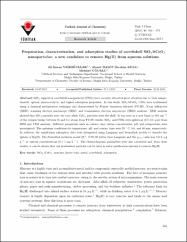Preparation, characterization, and adsorption studies of coreAshell SiO2-CeO2 nanoparticles: a new candidate to remove Hg(II) from aqueous solutions
Abstract
SiO2 supported core@shell nanoparticles (CSNs) have recently attracted great attention due to their unique, tunable, optical, photocatalytic, and higher adsorption properties. In this study, SiO2@CeO2 CSNs were synthesized using a chemical precipitation technique and characterized by Fourier transform infrared (FT-IR), X-ray diffraction (XRD), scanning electron microscope (SEM), and transmission electron microscope (TEM) analysis. XRD analysis showed that SiO2 particles were the core while CeO2 particles were the shell. It was seen as a new band at 961 cm(-1) of the oxygen bridge between Si and Ce atoms from FT-IR results; SiO2 and CSNs were spherical (0.5-0.6 mu m) from SEM and TEM analyses. Different parameters such as contact time, initial concentration, pH, and temperature were investigated. The optimum conditions for temperature, pH, and contact time were 25 degrees C, 8.0, and 60 min, respectively. In addition, the equilibrium adsorption data were interpreted using Langmuir and Freundlich models to describe the uptake of Hg(II). The Freundlich isotherm model (R-2: 0.99) fit better than Langmuir and the q(max) value was 153.8 mu g g(-1) at various concentrations (0.1-1 mg L-1). The thermodynamic parameters were also calculated and, from these results, it can be shown that our synthesized particles can be used in water purification systems to remove Hg(II).


















